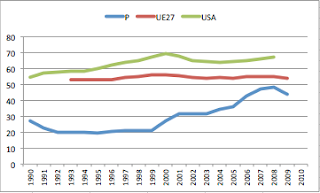Previous
posts have discussed how strongly R&D spending changes between
different business sectors and different sizes of firms.
It
is obvious that Portugal and USA economies are very different, not only
in size, but specially in structure. The largest contributors to
R&D in USA are sectors not important in Portuguese economy. And
statistics about firms show a near total absence of very large firms
(larger than 10000 people, even larger than 5000 people) in Portugal.
These structural differences have obvious implications about R&D
expenses.
We
will consider only the effect of very large companies. We have shown
than firms larger than 10000 people contributed with half of the
business R&D in USA and they were much more committed to R&D
than the other firms. These kind of firms are not present in the
portuguese economy. In 2009 USA firms with more than 5000 people paid
and performed 137 b.USD of the total R&D bill (117 b for firms with
more than 10000 people). Basically there are not this kind of firms in
the portuguese economy. What
happens if that extra propensity to R&D disappears, assuming that their
contribution to the economy now would be through smaller companies
(less than 5000 people), with a propensity for business R&D around ⅓
of the propensity of very large companies?
If
these companies were not present in USA economy, but assuming the same
GDP, then business R&D would be smaller. From previous post, we
estimate that ⅔ of business R&D the larger firms (>5000 people).
This would mean ⅔ of 137 b.USD, or 91 b.USD - let’s assume a reduction
of 90 b.USD in USA business R&D (paid and performed by industry),
equivalent to 22.5% of R&D, and do a simple simulation.
Total
USA R&D becomes 310 b.USD, 2.2% of GDP (not 2.9%), industry R&D
would be 1.4% (not 2.1%). In this scenario the original gap between
Portugal and USA (measured by R&D as % GDP) changes from 1.28% to
0.63% - half of the original one. And R&D performed by industry now
compares 0.72% GDP (Portugal) versus 1.43%GDP (USA).
Our
conclusion: around half of the gap between Portugal and USA is due to
the structural effect of the higher propensity of very large companies
to perform R&D.
This
exercise did not consider the structural effect of different business
structure, by industry sectors, between Portugal and USA economies. Of
course size and sector effects are not independent neither fully
cumulative. But an additional effect of lower R&D intensity sectors
in the portuguese economy is indeed reasonable.
So let’s simulate of reduction of 120 b.USD in USA business R&D, instead of 90. The new gap between R&D intensity is from 1.6% GDP (Portugal) to 2.0% (USA, instead of 2.9%), so 0.4% instead of 1.3%, and industry performed R&D gap is from 0.7% to 1.2% (instead of 2.0%), so 0.5% instead of 1.35%.
So let’s simulate of reduction of 120 b.USD in USA business R&D, instead of 90. The new gap between R&D intensity is from 1.6% GDP (Portugal) to 2.0% (USA, instead of 2.9%), so 0.4% instead of 1.3%, and industry performed R&D gap is from 0.7% to 1.2% (instead of 2.0%), so 0.5% instead of 1.35%.
Our
next conclusion: on a very preliminary basis, our guess of the
additional effect of R&D intensity per industry sectors suggests
that may be the “real” gap between Portugal and USA may be only one
third of the “formal” one.
Next figure summarizes R&D % structure for these two scenarios (USA-90, USA-120) and the original ones for USA and Portugal.
Next figure summarizes R&D % structure for these two scenarios (USA-90, USA-120) and the original ones for USA and Portugal.





















